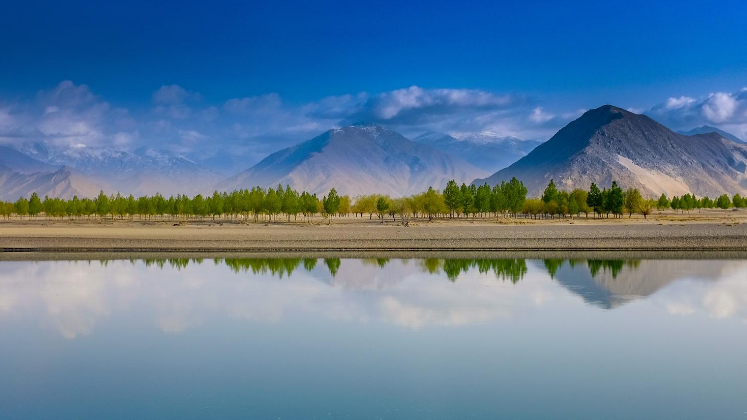In Islamic Shangri-La: Inter-Asian Relations and Lhasa’s Muslim Communities, 1600 to 1960, David G. Atwill investigates the neglected history of the Khache from the seventeenth to the twentieth century, with keen attention to the complexities and contradictions surrounding notions of identity, subjecthood and citizenship. This is a pioneering work in the study of Tibetan Muslims and an indispensable contribution to the growing literature and scholarship in Tibetan borderlands studies, writes Palden Gyal.
Islamic Shangri-La: Inter-Asian Relations and Lhasa’s Muslim Communities, 1600 to 1960. David G. Atwill. University of California Press. 2018.
 Tibet has never been ethnically, religiously nor linguistically monolithic. Tibet’s ethnic, religious and linguistic makeup has been complex and diverse at the cradle of Tibetan civilisation, Lhasa. As noted by travellers from overseas, from Ippolito Desideri to Ekai Kawaguchi, not only was Lhasa a cosmopolitan city, but the monastic universities in the vicinity were also international learning centres that attracted scholars from various Asian countries. In the same vein, the current situation of Tibetans in exile is more complex and multifaceted than conventional wisdom would have it.
Tibet has never been ethnically, religiously nor linguistically monolithic. Tibet’s ethnic, religious and linguistic makeup has been complex and diverse at the cradle of Tibetan civilisation, Lhasa. As noted by travellers from overseas, from Ippolito Desideri to Ekai Kawaguchi, not only was Lhasa a cosmopolitan city, but the monastic universities in the vicinity were also international learning centres that attracted scholars from various Asian countries. In the same vein, the current situation of Tibetans in exile is more complex and multifaceted than conventional wisdom would have it.
The case of Tibetan Muslims (Tib. Khache), their history and contemporary predicament offers fascinating and crucial insight into the aforementioned complexities of Tibetan society. Through careful study of previously untapped archival materials as well as interviews with members of various Khache communities in Lhasa and India, David G. Atwill’s Islamic Shangri-La investigates the long-ignored history of the Khache from the seventeenth to the twentieth century, with keen attention to the complexities and contradictions surrounding notions of identity, subjecthood and citizenship as Tibetans deal with their conception of national identity in terms of nation-state ideologies and policies.
As the title of the book suggests, with an allusion to Donald S. Lopez Jr.’s groundbreaking Prisoners of Shangri-La, Atwill argues that most overseas observers and their accounts of Lhasa and Central Tibet mistakenly portrayed the Khache as ‘outsiders’ or ‘foreigners’ because the Khache did not fit in their imaginary, singular and monolithic narrative of Tibetans as Buddhists and the city of Lhasa as the capital of the Buddhist kingdom.

Image Credit: ‘The Barkhor, Lhasa (39)’ by Richard Mortel licensed under CC BY 2.0
Atwill begins the book by carefully analysing the differences amongst the Tibetan Muslim communities, their respective histories and the multivalence of the term Khache in its contemporary usage. He demonstrates that historically Khache referred only to the Tibetan Muslims in Central Tibetan cities like Lhasa and Shigatse, not the Tibetan Muslims in Northeastern Tibet (Amdo), nor the Chinese Muslims (Hui) who have settled in different cities of Central Tibet in the past few decades. The contemporary usage of the term Khache or Zang-Hui for all Tibetan Muslims not only conceals the history of the Khache, but also undermines the cosmopolitan character and diversity of Lhasa and its inter-Asian connections before the twentieth century.
Atwill provides a clear historical context to the ethnic makeup and diversity of foreign residents in Lhasa. For instance, as many accounts by outside observers treated the Khache as similar to the Khatsara (half-Nepalese and half-Tibetan) with regard to their legal status and other privileges, this served to obscure the position of the Khache within Tibetan society. Unlike the Khatsaras, both Khaches and Kokos (half-Tibetan and half-Chinese) were fully accepted as Tibetans and were subject to Tibetan law, as evidenced by several examples of legal cases. After the Treaty of Thapathali (1856) between Tibet and Nepal, Nepalese traders and nationals gained extraterritorial rights in Tibet, which were also extended to the Khatsara.
Furthermore, Tibetan historical sources that are predominantly written by Tibetan Buddhists rarely addressed the Khache, despite their presence in Tibet for the past three centuries. Atwill contends:
Not abandoned or erased, the Khache have always remained in plain sight, yet never quite in focus. They have been screened off within the official chronicling of the past since they do not fit comfortably in the historical narrative of Tibet (12).
Islamic Shangri-La challenges the master narratives of contemporary Tibetan history and national identity, and provides an alternative ‘history from below’ as the narrative of the Khache uncovers what Dipesh Chakrabarty defines as their ‘subaltern past’. It makes an important intervention in highlighting the process by which imaginings of national identity are produced, reified and naturalised through the nationalist discourse of Tibetans in exile.
Although the Khache rarely appear in Tibetan historical sources as noted above, the Khache are known for their linguistic ability and literary gift. For instance, one of the greatest secular Tibetan works of socio-moral teaching is Advice on the Art of Living by Faizullah, a Tibetan Muslim who wrote under the sobriquet Khache Phalu. The Khache seamlessly integrated into Tibetan society as the community evolved and expanded through intermarriage with local Tibetans who converted to Islam, and their multilingualism (Tibetan, Hindi, Chinese and English) and commercial expertise allowed them to serve as guides for outsiders in Tibet since the seventeenth century.
When the current Dalai Lama fled into exile and the People’s Republic of China completed the takeover of Tibet in 1959, the status of the Khache in Tibet altered permanently. As the Chinese Communist Party began its campaign of terror in the name of ‘liberating’ Tibetans from the shackles of ‘feudalism’, the Khache (Barkor Khaches in particular) decided to rethink their identity and assert their historical and ancestral Indian or Kashmiri identity, following the Khatsaras who immediately claimed their Nepalese citizenship and returned to Nepal. For the Chinese officials, the Khache’s denial of Tibetan identity was equivalent to declining Chinese citizenship, and thus demanded proof of their Indian citizenship. While the majority of the Khache couldn’t prove their Indian ancestry, some never even tried to leave Tibet, but close to one thousand Khaches left Tibet legally as ‘Indians’ in 1960 after a year-long political negotiation between the Governments of India and China concerning the status of the Lhasa Khache. In the midst of fear and tragedy, the Khache returned ‘home’ to India only to realise what their ‘repatriation’ entailed and to endure its consequences.
When the Dalai Lama and thousands of Tibetans escaped into India, they were provided with Registration Certificates (RC) which gave them the legal status of ‘foreigners’, and this self-proclaimed ‘refusal’ of Indian citizenship became a rallying point of the Tibetan political movement in exile – a symbolic act of patriotism and political struggle. Therefore, in the eyes of the newly arrived Tibetans in exile who were predominantly Buddhists, the Khache not only betrayed Tibet but also forfeited their Tibetan identity the moment they exited Tibet as ‘Indians’.
On the one hand, the Khache were excluded from the Tibetan exile community. For instance, the Khache as ‘Indian citizens’ weren’t given representation in the parliament of the Tibetan Government in Exile. On the other hand, the State of Jammu and Kashmir did not consider the Khache as Kashmiri Indians but treated them as Tibetan refugees, and even today they still struggle to integrate into Kashmiri society. Ironically, the refusal of state citizenship by the government of Jammu and Kashmir placed the Khache in a position and predicament similar to the rest of the Tibetans in India. Atwill’s study aids in clearing certain misconceptions between the Khache and the rest of the Tibetan exile community and in bringing the estranged communities closer.
The recent history and experience of the Khache in India, especially those settled in Srinagar, underscore how the prevailing categories and concepts of national identity and citizenship are inadequate to explain and account for the Khache’s transnational identity. The fluidity of the Khache’s identity forces us to rethink such concepts and categories in light of the diversity and hybridity in the ethnic, linguistic and religious makeup of Tibet. In the context of the ‘decolonisation’ or reterritorialisation of Asia in the nineteenth and twentieth centuries, Atwill does an excellent job of presenting how the case of the Lhasa Khache serves as an analytic lens that captures the changing relationship between space and identity. Islamic Shangri-La is a pioneering work in the study of Tibetan Muslims and an indispensable contribution to the growing literature and scholarship in Tibetan borderlands studies. Through painstaking scrutiny of a wide variety of archival materials, Atwill has produced an original work and delivers it in a style that is accessible to both specialists and non-specialists of Tibetan and Himalayan history and culture and of modern Asian history.
Note: This review gives the views of the author, and not the position of the LSE Review of Books blog, or of the London School of Economics and Political Science.







